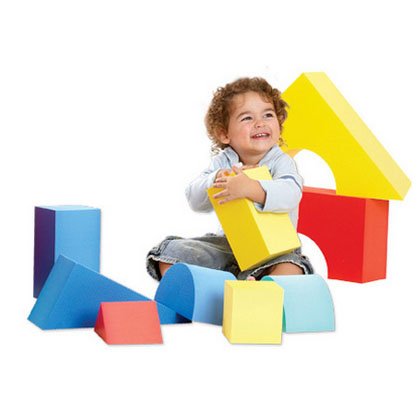Teaching shapes to children
By Catalogs Editorial Staff

Tips for teaching shapes to children to develop motor and sensory skills
There are countless ways to introduce kids to shapes. Some of the most effective methods are simple games and activities designed to stimulate developmental learning through play.
Babies come into to this world with an innate ability to understand sounds and shapes. They can see and feel circles and triangles. As they grow and play with puzzles, trying to fit a square peg in a triangular hole, they begin to see the differences between them.
Teaching shapes to children involves helping them learn the names, compare them and explore the different ways they can be used. Developing these skills will help them when they begin learning to read ? at first they?ll recognize the shapes of words for their straight and curvy letters.
From bath toys and building sets to puzzles and shape sorters, educational activities engage kids? natural curiosity. Every child is different, so try different types until finding a few that hold your little one?s attention. You can even make your own games with some basic materials like construction paper and scissors.
Show and tell
Describing places and objects in sight helps young children understand their environment. Simply sitting on the floor with them while they play and pointing out the shapes of their toys helps. Show and describe how a ball rolls or how a block is flat on all sides so you can stack a triangle on top.
~
Kids pay attention when you show them a cause and effect. For instance, touching the pointy tip of a triangle or corner of a square can hurt. Boat-shaped objects with rounded edges can rock back and forth. Show and tell them about these shapes, then have them roll the ball, stack the blocks and rock the boat themselves.
Memorable associations
Remember, this information is all new so don?t overload young learners with too much too fast. Focus on one shape every week or month and slowly bring them together for comparison. Have them make the same shape in different sizes and colors using play dough or construction paper.
Teaching shapes to children is fun when you try different activities, crafts and educational toys. Associate some with the seasons, holidays and other themes so they learn that everything in the world is made up of different angles and curves. Make a game of what different shapes represent – rectangles for the long dinner table on Thanksgiving, green triangles for Christmas trees, white circles for snowman and colorful ones for balloons.
Practice games
An easy and fun way to practice what they?ve learned is with a BINGO game. Make your own boards and cards with crayons and paper. Show a card and have them match it to the one on their board. Making flashcards is another way to see what they remember and which ones to work on some more.
Homemade activities
Fill an empty box with about an inch of sand. Cut out shapes from stiff, colorful paper or cardboard and spread them in the box under the sand. Hold up a flashcard and have your child find the corresponding shape.
Cut our matching pairs of shapes from different colors of felt ? two red hearts, two yellow stars, two green triangles. Mix them all up and spread them out. Ask her to match up the twins.
Here?s a quick game to play at home to show your kiddies that shapes are all around. Give them a few flashcards, paper and a crayon. Have them trace objects in their bedroom that are circles, squares and cylinders. This encourages them to think about what they see and notice commonalities.
Older children looking for more complex challenges are ready for jigsaw puzzles, Tetris and making their own mosaics and collages.
Teaching shapes to children helps them begin to flex essential learning skills. It?s also a fun way to spend quality time with them and gain sense of how they learn and interpret the world.
Popular Savings Offers











